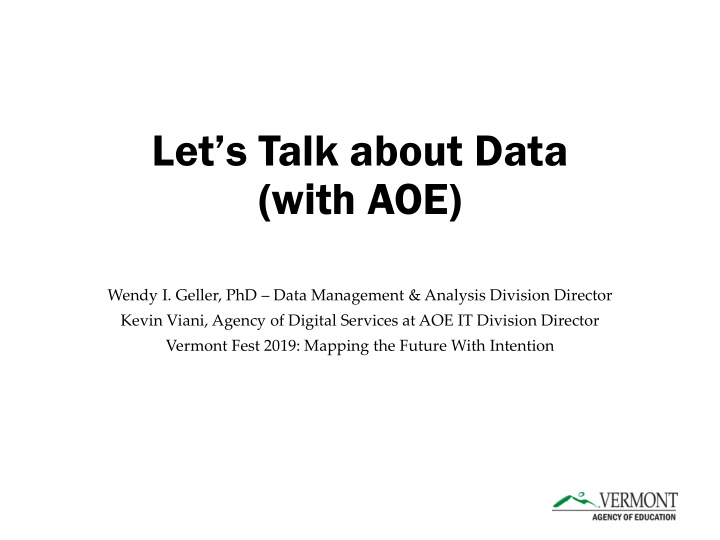



Let’s Talk about Data (with AOE) Wendy I. Geller, PhD – Data Management & Analysis Division Director Kevin Viani, Agency of Digital Services at AOE IT Division Director Vermont Fest 2019: Mapping the Future With Intention
Raise your hand if… You experience You would like • Disjointed approach to tool and skill • Shared approach to modernization modernization across IT and Data (IT – Data Partnership; LEA-SEA teams partnership) • Standardized operating procedures • Many, disparate points of data for all data collections collection • Master data management to • Many, non-integrated data sets facilitate data integration • Single, unified data model or data • No single, unified data model tool (e.g. AOE is adopting CEDS • Patchy, non-standard process NDS) documentation • Centrally managed, enterprise-wide governance • Non-uniform application of • Scalable, portable, repeatable governance processes • Heavy reliance on non-scalable • Automated production of processes compliance reporting, interactive dashboards, slack for value-added • Heavy reliance on manual work to analysis meet compliance reporting • Data stewards, analysts, specialist • Data stewards, analysts, specialist teams centrally unified together teams federated across the organization
Resource constraints Aging infrastructure Deferred maintenance $cant budget Overallocated staff Fear of change Struggling morale Technical debt burden But how to get there? Image: IT Crowd Watch the clip
Finding North • Examine and Define Current State - warts and all (i.e. where you are right now) • Take a deep breath. Don’t panic. • Define Future State (i.e. where you want to be) • Start with the basics • Examine your processes (and write them down if they aren’t already) • If you know what your process is, you can improve your process • If you can improve your process, your work will improve • Ask for help when you need it • Give help to others if you can Image credit
Current State: AOE’s Historic Data/IT Landscape • Point to Point • Reliance on Data Program Staff • Brittle • Labor Intensive Figure: Diagram of an overly complex process that moves between too many data sources to various data program staff and outputs.
Future State: Enterprise Infrastructure • Data Centric • Free up Resources • Resilient to Change • Support Continuous Improvement Figure: Logical model showing linear processes between data sources, people, processes, tools, services, and data, and then uses as an end result. [Image Credit: The Eckerson Group]
3-5 Year Breakthrough Objectives Today, together, let’s focus on these: 1. Modernize, standardize, and fully leverage collection, management, storage, and data analysis platforms, tools, and methodologies. 2. Move a from reactive culture to proactive culture. 3. Effectively coordinate to execute cross-functional workflows. 4. Strengthen security and privacy frameworks while reducing burden of supporting secure and sound data handling. 5. Empower AOE and stakeholders with data to support an evidence and result-based approach to decision making.
Move from reactive culture to proactive culture Ask for help when you need it. Give help to others if you can. NCES Data Forum Best Practices Guides We don’t have to go it alone. We don’t have to solve everything ourselves.
Effectively coordinate resources to execute cross-functional workflows Reduce, Reuse, Recycle • Adopt and deploy all the federal tools to support standard work. Modify as needed (and only if needed). • Document and then improve our processes. Improving our processes helps us improve our work, together . • Scale processes if we can’t scale people.
The AOE/ADS team continues to work towards a strong yet nimble infrastructure that allows the organization to focus on improving processes instead of managing them. Conversation?
Recommend
More recommend